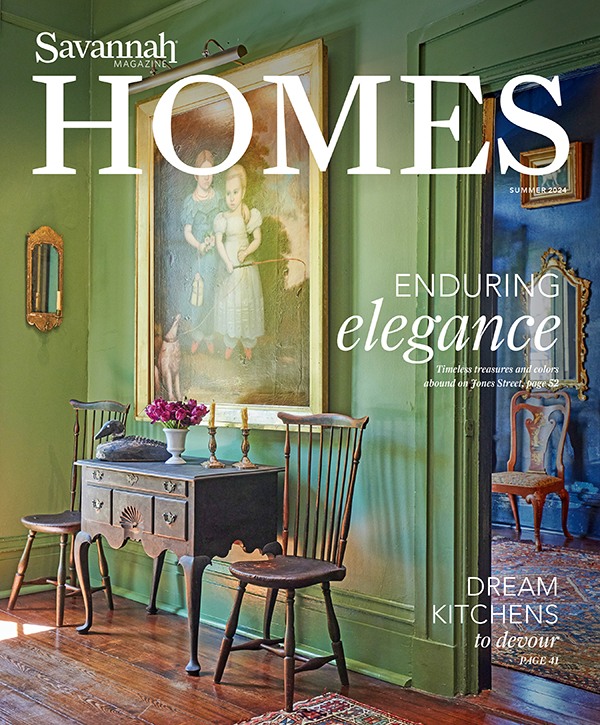7 of the city’s premier purveyors of fine furnishings reflect on their best scores, shop etiquette and the pieces that got away
Photography by MICHAEL SCHALK
THE WORLD OF brown furniture — an umbrella term for heirlooms of all varieties — was brazenly pronounced dead in 2019, according to articles published in The Wall Street Journal and Financial Times, among others. No longer were children pining after their parents’ Federalist dining tables, Victorian consoles or fine china. Experts declared the avant garde and midcentury modern en vogue for the foreseeable future with antiquities destined for the dump.
However, despite these predictions, the stratospheric rise of “grandmillennial” style (think granny-chic chintzes, Staffordshire dogs, needlepoint pillows, etc.), year-long lead times (thanks, COVID), and the search for personal style, brought a welcome boost to the antiques business from a younger population eager to eschew fast consumerism and get educated on the value of good, old things.
How does one enter the brave old world of brown furniture and beyond? Read on for tips, tricks and tales from Savannah’s antique aficionados boasting over 300 years of experience between them.

BUY WHAT YOU LIKE (AS SOON AS YOU SEE IT)
For James Plumlee, owner of Picker Joe’s Antique Mall & Vintage Market, the cardinal rule of antiquing is simple: “When you see something cool, you should buy it,” he says.
And once you find what you love, hold onto it.
Robin Napoli, co-owner of Jones & Bull, says she once found a cane online advertised as an antique carved cane with a man’s image.
“I immediately recognized it was supposed to be Abraham Lincoln on the front. On the back, it had a knot where a bullet hole would have been,” she says. After discovering the cane was an invaluable piece of POW art — works made in Civil War prison camps traded for food and other necessities — she sold the piece to a Lincoln enthusiast friend.
“To this day, I am not happy with myself for selling it,” says Napoli. “I told him if he ever [thinks] about getting rid of it, he has to contact me first.”
But, as Kevin Johnson at Peridot Antiques discovered, sometimes letting go is for the greater good.
“The most valuable piece I discovered was a 19th century Korean ancestor portrait cleared out from an estate in NYC. There was just something about it that was different from others I had seen,” Johnson says. When the National Museum of Korea scooped up the piece at auction, his instincts were proven sound. “It ended up being a lost image of cultural Significance,” he says.

BE RELENTLESS
In antiquing, sky-high bids, spider-infested corners and dark crawl spaces are occupational hazards.
“I think I’m jaded because nothing seems [too] crazy for a piece you just have to have,” says Brooke Chancey, co-owner of Clutter Furnishings & Interiors.
Jere Myers, owner of Jere’s Antiques, seconds the notion. “If I want it, I’m going to take the damn thing home!”
Eager to bring home an original airport beacon from 1942, Plumlee faced his fear of heights. The piece, mounted atop a 200-foot tower, was up for grabs if he could get it down. With climbing gear and a buddy, Plumlee got to work.
“It took a few hours of nerves and some ingenuity, but we got it down and back to the shop,” says Plumlee.
SHOP LOCAL, FAR AND WIDE
Savannah boasts a uniquely qualified cadre of antique experts inspired by what Plumlee calls “PFTP” or “passion for the past.”
On the hunt for a specific period piece or after more information? Simply ask.
“I would love for people to have more knowledge of what they are looking at, and it is my job to teach them,” says Myers.
With encyclopedic knowledge and connections across the globe, these shop owners are your best resource for one-of-a-kind finds. “We have eyes and ears everywhere and consignors with the coolest furnishings,” says Chancey.
And if you happen to lose a beloved piece, take heart. “There really are only a few degrees of separation, and the world gets smaller every day,” reflects Lynn Rahn, co-owner of Clutter. “If it got away, there’s a good chance we will see it again.”
MIND YOUR MANNERS
When shopping for antiques — whether at a flea market or specialty shop — etiquette is everything. Think of the Golden Rule and treat others the way you want to be treated. While asking for a discount is allowed — and sometimes expected — lead with kindness and consideration.
“When someone comes into our shop and says, ‘Is that the best you can do?’ I find that to be rude,” says Napoli. Instead, she suggests asking, “Is this something you would consider taking less for?”
Unsure about an item’s patina? Consider the value of its age and use. “[Shoppers] will find a farmhouse table from the 1800s and say, ‘It has a ding in it,’” says Brenda Anderson, who co-operates Tapley’s Mercantile & Antiques.
The goal, she suggests, is finding pieces of great integrity — those that have withstood the test of time and heavy use.
“Think of the stories that come from every little mark on an antique, where it’s been,” says Anderson. “If you want something new, you go to a furniture store. If you want something well-loved, come to our store.”



